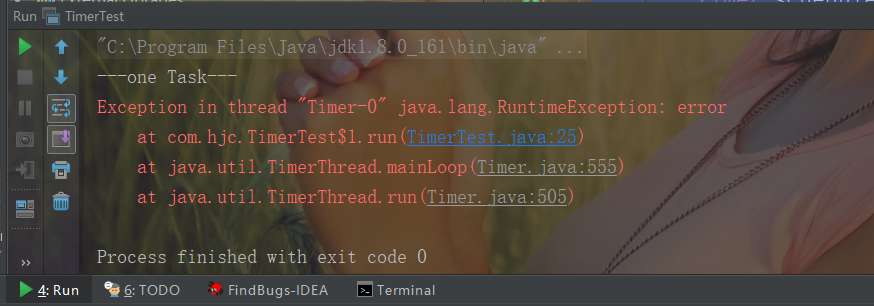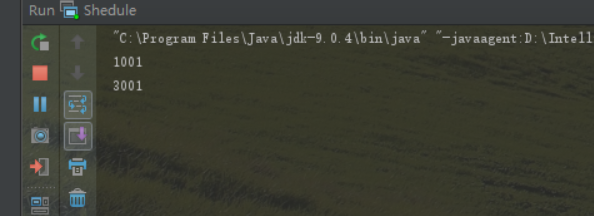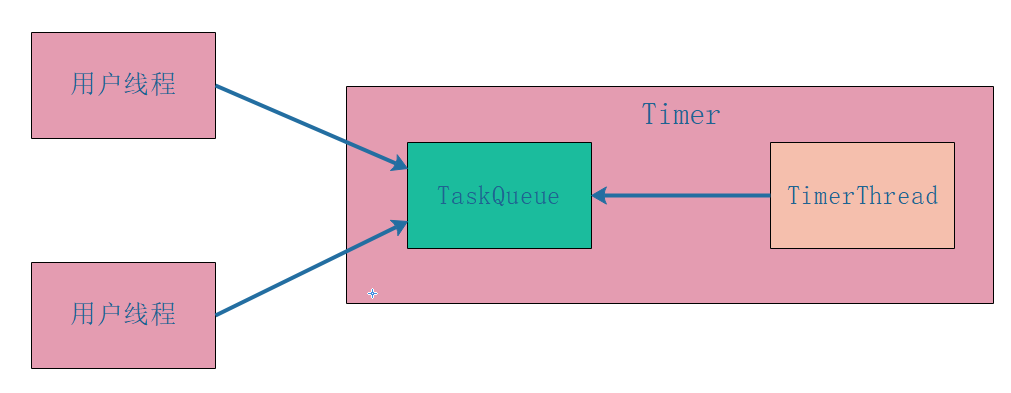жӮЁеҘҪпјҢзҷ»еҪ•еҗҺжүҚиғҪдёӢи®ўеҚ•е“ҰпјҒ
timerеңЁJDKйҮҢйқўпјҢжҳҜеҫҲж—©зҡ„дёҖдёӘAPIдәҶгҖӮе…·жңү延时зҡ„пјҢ并具жңүе‘ЁжңҹжҖ§зҡ„д»»еҠЎпјҢеңЁnewScheduledThreadPoolеҮәжқҘд№ӢеүҚжҲ‘们дёҖиҲ¬дјҡз”ЁTimerе’ҢTimerTaskжқҘеҒҡпјҢдҪҶжҳҜTimerеӯҳеңЁдёҖдәӣзјәйҷ·пјҢдёәд»Җд№Ҳиҝҷд№ҲиҜҙе‘ўпјҹ
TimerеҸӘеҲӣе»әе”ҜдёҖзҡ„зәҝзЁӢжқҘжү§иЎҢжүҖжңүTimerд»»еҠЎгҖӮеҰӮжһңдёҖдёӘtimerд»»еҠЎзҡ„жү§иЎҢеҫҲиҖ—ж—¶пјҢдјҡеҜјиҮҙе…¶д»–TimerTaskзҡ„ж—¶ж•ҲеҮҶзЎ®жҖ§еҮәй—®йўҳгҖӮдҫӢеҰӮдёҖдёӘTimerTaskжҜҸ10з§’жү§иЎҢдёҖж¬ЎпјҢиҖҢеҸҰеӨ–дёҖдёӘTimerTaskжҜҸ40msжү§иЎҢдёҖж¬ЎпјҢйҮҚеӨҚеҮәзҺ°зҡ„д»»еҠЎдјҡеңЁеҗҺжқҘзҡ„д»»еҠЎе®ҢжҲҗеҗҺеҝ«йҖҹиҝһз»ӯзҡ„иў«и°ғз”Ё4ж¬ЎпјҢиҰҒд№Ҳе®Ңе…ЁвҖңдёўеӨұвҖқ4ж¬Ўи°ғз”ЁгҖӮTimerзҡ„еҸҰеӨ–дёҖдёӘй—®йўҳеңЁдәҺпјҢеҰӮжһңTimerTaskжҠӣеҮәжңӘжЈҖжҹҘзҡ„ејӮеёёдјҡз»ҲжӯўtimerзәҝзЁӢгҖӮиҝҷз§Қжғ…еҶөдёӢпјҢTimerд№ҹдёҚдјҡйҮҚж–°еӣһеӨҚзәҝзЁӢзҡ„жү§иЎҢдәҶпјӣе®ғй”ҷиҜҜзҡ„и®Өдёәж•ҙдёӘTimerйғҪиў«еҸ–ж¶ҲдәҶгҖӮжӯӨж—¶е·Із»Ҹиў«е®үжҺ’дҪҶе°ҡжңӘжү§иЎҢзҡ„TimerTaskж°ёиҝңдёҚдјҡеҶҚжү§иЎҢдәҶпјҢж–°зҡ„д»»еҠЎд№ҹдёҚиғҪиў«и°ғеәҰдәҶгҖӮ
иҝҷйҮҢеҒҡдәҶдёҖдёӘе°Ҹзҡ„ demo жқҘеӨҚзҺ°й—®йўҳпјҢд»Јз ҒеҰӮдёӢпјҡ
package com.hjc;
import java.util.Timer;
import java.util.TimerTask;
/**
* Created by cong on 2018/7/12.
*/
public class TimerTest {
//еҲӣе»әе®ҡж—¶еҷЁеҜ№иұЎ
static Timer timer = new Timer();
public static void main(String[] args) {
//ж·»еҠ д»»еҠЎ1,延иҝҹ500msжү§иЎҢ
timer.schedule(new TimerTask() {
@Override
public void run() {
System.out.println("---one Task---");
try {
Thread.sleep(1000);
} catch (InterruptedException e) {
e.printStackTrace();
}
throw new RuntimeException("error ");
}
}, 500);
//ж·»еҠ д»»еҠЎ2пјҢ延иҝҹ1000msжү§иЎҢ
timer.schedule(new TimerTask() {
@Override
public void run() {
for (;;) {
System.out.println("---two Task---");
try {
Thread.sleep(1000);
} catch (InterruptedException e) {
// TODO Auto-generated catch block
e.printStackTrace();
}
}
}
}, 1000);
}
}
еҰӮдёҠд»Јз Ғе…Ҳж·»еҠ дәҶдёҖдёӘд»»еҠЎеңЁ 500ms еҗҺжү§иЎҢпјҢ然еҗҺж·»еҠ дәҶ第дәҢдёӘд»»еҠЎеңЁ 1s еҗҺжү§иЎҢпјҢжҲ‘们жңҹжңӣзҡ„жҳҜеҪ“第дёҖдёӘд»»еҠЎиҫ“еҮә ---one Task--- еҗҺзӯүеҫ… 1s еҗҺ第дәҢдёӘд»»еҠЎдјҡиҫ“еҮә ---two Task---пјҢ
дҪҶжҳҜжү§иЎҢе®ҢжҜ•д»Јз ҒеҗҺиҫ“еҮәз»“жһңеҰӮдёӢжүҖзӨәпјҡ

дҫӢеӯҗ2пјҢ
public class Shedule {
private static long start;
public static void main(String[] args) {
TimerTask task = new TimerTask() {
public void run() {
System.out.println(System.currentTimeMillis()-start);
try{
Thread.sleep(3000);
}catch (InterruptedException e){
e.printStackTrace();
}
}
};
TimerTask task1 = new TimerTask() {
@Override
public void run() {
System.out.println(System.currentTimeMillis()-start);
}
};
Timer timer = new Timer();
start = System.currentTimeMillis();
//еҗҜеҠЁдёҖдёӘи°ғеәҰд»»еҠЎпјҢ1Sй’ҹеҗҺжү§иЎҢ
timer.schedule(task,1000);
//еҗҜеҠЁдёҖдёӘи°ғеәҰд»»еҠЎпјҢ3Sй’ҹеҗҺжү§иЎҢ
timer.schedule(task1,3000);
}
}
дёҠйқўзЁӢеәҸжҲ‘们预жғіжҳҜ第дёҖдёӘд»»еҠЎжү§иЎҢеҗҺпјҢ第дәҢдёӘд»»еҠЎ3SеҗҺжү§иЎҢзҡ„пјҢеҚіиҫ“еҮәдёҖдёӘ1000пјҢдёҖдёӘ3000.
е®һйҷ…иҝҗиЎҢз»“жһңеҰӮдёӢпјҡ

е®һйҷ…иҝҗиЎҢз»“жһң并дёҚеҰӮжҲ‘们жүҖж„ҝгҖӮдё–з•Ңз»“жһңпјҢжҳҜиҝҮдәҶ4SеҗҺжүҚиҫ“еҮә第дәҢдёӘд»»еҠЎпјҢеҚі4001зәҰзӯүдәҺ4з§’гҖӮйӮЈйғЁеҲҶж—¶й—ҙж—¶й—ҙеҲ°е“ӘйҮҢеҺ»дәҶе‘ўпјҹйӮЈдёӘж—¶й—ҙжҳҜиў«жҲ‘们第дёҖдёӘд»»еҠЎзҡ„sleepжүҖеҚ з”ЁдәҶгҖӮ
зҺ°еңЁжҲ‘们еңЁз¬¬дёҖдёӘд»»еҠЎдёӯеҺ»жҺүThread.sleepпјҲпјүпјӣиҝҷдёҖиЎҢд»Јз ҒпјҢиҝҗиЎҢжҳҜеҗҰжӯЈзЎ®дәҶе‘ўпјҹиҝҗиЎҢз»“жһңеҰӮдёӢпјҡ

еҸҜд»ҘзңӢеҲ°зЎ®е®һжҳҜ第дёҖдёӘд»»еҠЎиҝҮдәҶ1SеҗҺжү§иЎҢпјҢ第дәҢдёӘд»»еҠЎеңЁз¬¬дёҖдёӘд»»еҠЎжү§иЎҢе®ҢеҗҺиҝҮ3Sжү§иЎҢдәҶгҖӮ
иҝҷе°ұиҜҙжҳҺдәҶTimerеҸӘеҲӣе»әе”ҜдёҖзҡ„зәҝзЁӢжқҘжү§иЎҢжүҖжңүTimerд»»еҠЎгҖӮеҰӮжһңдёҖдёӘtimerд»»еҠЎзҡ„жү§иЎҢеҫҲиҖ—ж—¶пјҢдјҡеҜјиҮҙе…¶д»–TimerTaskзҡ„ж—¶ж•ҲеҮҶзЎ®жҖ§еҮәй—®йўҳгҖӮ
Timer е®һзҺ°еҺҹзҗҶеҲҶжһҗ
дёӢйқўз®ҖеҚ•д»Ӣз»ҚдёӢ Timer зҡ„еҺҹзҗҶпјҢеҰӮдёӢеӣҫжҳҜ Timer зҡ„еҺҹзҗҶжЁЎеһӢд»Ӣз»Қпјҡ

1.е…¶дёӯ TaskQueue жҳҜдёҖдёӘе№іиЎЎдәҢеҸүж ‘е Ҷе®һзҺ°зҡ„дјҳе…Ҳзә§йҳҹеҲ—пјҢжҜҸдёӘ Timer еҜ№иұЎеҶ…йғЁжңүе”ҜдёҖдёҖдёӘ TaskQueue йҳҹеҲ—гҖӮз”ЁжҲ·зәҝзЁӢи°ғз”Ё timer зҡ„ schedule ж–№жі•е°ұжҳҜжҠҠ TimerTask д»»еҠЎж·»еҠ еҲ° TaskQueue йҳҹеҲ—пјҢеңЁи°ғз”Ё schedule зҡ„ж–№жі•ж—¶еҖҷ long delay еҸӮж•°з”ЁжқҘиҜҙжҳҺиҜҘд»»еҠЎе»¶иҝҹеӨҡе°‘ж—¶й—ҙжү§иЎҢгҖӮ
2.TimerThread жҳҜе…·дҪ“жү§иЎҢд»»еҠЎзҡ„зәҝзЁӢпјҢе®ғд»Һ TaskQueue йҳҹеҲ—йҮҢйқўиҺ·еҸ–дјҳе…Ҳзә§жңҖе°Ҹзҡ„д»»еҠЎиҝӣиЎҢжү§иЎҢпјҢйңҖиҰҒжіЁж„Ҹзҡ„жҳҜеҸӘжңүжү§иЎҢе®ҢдәҶеҪ“еүҚзҡ„д»»еҠЎжүҚдјҡд»ҺйҳҹеҲ—йҮҢйқўиҺ·еҸ–дёӢдёҖдёӘд»»еҠЎиҖҢдёҚз®ЎйҳҹеҲ—йҮҢйқўжҳҜеҗҰжңүе·Із»ҸеҲ°дәҶи®ҫзҪ®зҡ„ delay ж—¶й—ҙпјҢдёҖдёӘ Timer еҸӘжңүдёҖдёӘ TimerThread зәҝзЁӢпјҢжүҖд»ҘеҸҜзҹҘ Timer зҡ„еҶ…йғЁе®һзҺ°жҳҜдёҖдёӘеӨҡз”ҹдә§иҖ…еҚ•ж¶Ҳиҙ№иҖ…жЁЎеһӢгҖӮ
д»Һе®һзҺ°жЁЎеһӢеҸҜд»ҘзҹҘйҒ“иҰҒжҺўз©¶дёҠйқўзҡ„й—®йўҳеҸӘйңҖзңӢ TimerThread зҡ„е®һзҺ°е°ұеҸҜд»ҘдәҶпјҢTimerThread зҡ„ run ж–№жі•дё»иҰҒйҖ»иҫ‘жәҗз ҒеҰӮдёӢпјҡ
public void run() {
try {
mainLoop();
} finally {
// жңүдәәжқҖжӯ»дәҶиҝҷдёӘзәҝзЁӢпјҢиЎЁзҺ°еҫ—еҘҪеғҸTimerе·ІеҸ–ж¶Ҳ
synchronized(queue) {
newTasksMayBeScheduled = false;
queue.clear(); // ж¶ҲйҷӨиҝҮж—¶зҡ„еј•з”Ё
}
}
}
private void mainLoop() {
while (true) {
try {
TimerTask task;
boolean taskFired;
//д»ҺйҳҹеҲ—йҮҢйқўиҺ·еҸ–д»»еҠЎж—¶еҖҷиҰҒеҠ й”Ғ
synchronized(queue) {
......
}
if (taskFired)
task.run();//жү§иЎҢд»»еҠЎ
} catch(InterruptedException e) {
}
}
}
еҸҜзҹҘеҪ“д»»еҠЎжү§иЎҢиҝҮзЁӢдёӯжҠӣеҮәдәҶйҷӨ InterruptedException д№ӢеӨ–зҡ„ејӮеёёеҗҺпјҢе”ҜдёҖзҡ„ж¶Ҳиҙ№зәҝзЁӢе°ұдјҡеӣ дёәжҠӣеҮәејӮеёёиҖҢз»ҲжӯўпјҢйӮЈд№ҲйҳҹеҲ—йҮҢйқўзҡ„е…¶д»–еҫ…жү§иЎҢзҡ„д»»еҠЎе°ұдјҡиў«жё…йҷӨгҖӮжүҖд»Ҙ TimerTask зҡ„ run ж–№жі•еҶ…жңҖеҘҪдҪҝз”Ё try-catch з»“жһ„ catch дё»еҸҜиғҪзҡ„ејӮеёёпјҢдёҚиҰҒжҠҠејӮеёёжҠӣеҮәеҲ° run ж–№жі•еӨ–гҖӮ
е…¶е®һиҰҒе®һзҺ°зұ»дјј Timer зҡ„еҠҹиғҪдҪҝз”Ё ScheduledThreadPoolExecutor зҡ„ schedule жҳҜжҜ”иҫғеҘҪзҡ„йҖүжӢ©гҖӮScheduledThreadPoolExecutor дёӯзҡ„дёҖдёӘд»»еҠЎжҠӣеҮәдәҶејӮеёёпјҢе…¶д»–д»»еҠЎдёҚеҸ—еҪұе“Қзҡ„гҖӮ
ScheduledThreadPoolExecutor дҫӢеӯҗеҰӮдёӢпјҡ
/**
* Created by cong on 2018/7/12.
*/
public class ScheduledThreadPoolExecutorTest {
static ScheduledThreadPoolExecutor scheduledThreadPoolExecutor = new ScheduledThreadPoolExecutor(1);
public static void main(String[] args) {
scheduledThreadPoolExecutor.schedule(new Runnable() {
public void run() {
System.out.println("---one Task---");
try {
Thread.sleep(1000);
} catch (InterruptedException e) {
e.printStackTrace();
}
throw new RuntimeException("error ");
}
}, 500, TimeUnit.MICROSECONDS);
scheduledThreadPoolExecutor.schedule(new Runnable() {
public void run() {
for (int i =0;i<5;++i) {
System.out.println("---two Task---");
try {
Thread.sleep(1000);
} catch (InterruptedException e) {
e.printStackTrace();
}
}
}
}, 1000, TimeUnit.MICROSECONDS);
scheduledThreadPoolExecutor.shutdown();
}
}
иҝҗиЎҢз»“жһңеҰӮдёӢпјҡ

д№ӢжүҖд»Ҙ ScheduledThreadPoolExecutor зҡ„е…¶д»–д»»еҠЎдёҚеҸ—жҠӣеҮәејӮеёёзҡ„д»»еҠЎзҡ„еҪұе“ҚжҳҜеӣ дёә ScheduledThreadPoolExecutor дёӯзҡ„ ScheduledFutureTask д»»еҠЎдёӯ catch жҺүдәҶејӮеёёпјҢдҪҶжҳҜеңЁзәҝзЁӢжұ д»»еҠЎзҡ„ run ж–№жі•еҶ…дҪҝз”Ё catch жҚ•иҺ·ејӮ常并жү“еҚ°ж—Ҙеҝ—жҳҜжңҖдҪіе®һи·өгҖӮ
е…ҚиҙЈеЈ°жҳҺпјҡжң¬з«ҷеҸ‘еёғзҡ„еҶ…е®№пјҲеӣҫзүҮгҖҒи§Ҷйў‘е’Ңж–Үеӯ—пјүд»ҘеҺҹеҲӣгҖҒиҪ¬иҪҪе’ҢеҲҶдә«дёәдё»пјҢж–Үз« и§ӮзӮ№дёҚд»ЈиЎЁжң¬зҪ‘з«ҷз«ӢеңәпјҢеҰӮжһңж¶үеҸҠдҫөжқғиҜ·иҒ”зі»з«ҷй•ҝйӮ®з®ұпјҡis@yisu.comиҝӣиЎҢдёҫжҠҘпјҢ并жҸҗдҫӣзӣёе…іиҜҒжҚ®пјҢдёҖз»ҸжҹҘе®һпјҢе°Ҷз«ӢеҲ»еҲ йҷӨж¶үе«ҢдҫөжқғеҶ…е®№гҖӮ
жӮЁеҘҪпјҢзҷ»еҪ•еҗҺжүҚиғҪдёӢи®ўеҚ•е“ҰпјҒ